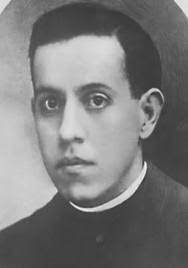Miguel Pro was born on January 13, 1891 in Guadalupe in the State of Zacatecas, Mexico to a mining family. From a young age, everyone called him “Cocol.” When he was about twenty years old, Miguel joined the Society of Jesus in the State of Michoacán, Mexico. One of his Jesuit friends said that Miguel was like two people: one a very playful, witty person, and the other a prayerful one.
Miguel studied in Mexico until 1914 when a wave of anti-Catholicism in Mexico forced the Jesuits to flee to California. From there, Miguel was sent to study in Spain, Nicaragua, and Belgium. He was ordained in 1925 in Belgium. A couple of months later, he became very ill with ulcers and had some operations. Throughout his suffering, he remained courageous and cheerful.
In 1926, the Jesuits sent him the State of Veracruz, Mexico. Unfortunately, this was during the presidency of Plutarco Elías Calles who was vigorously enforcing the anti-Catholic provisions of the Mexican Constitution of 1917. For example, the Church was forbidden to operate schools, monastic orders were outlawed, and basic civil liberties were taken away from priests and Religious.
To work as a Catholic priest was very risky in Mexico at that time. This did not, however, deter Fr. Miguel from serving the people. He disguised himself, at various times, as a mechanic, a student, or a man walking his dog. He would go from house to house baptizing infants, hearing confessions, blessing marriages, celebrating the Sacrament of the Sick for the dying, and consoling the people.
Meanwhile, a movement of Cristeros was growing in Mexico. These were Catholic Christians who were fighting the anti-Catholic government. Fr. Miguel was part of that movement, a movement that made the government very nervous. With his brothers Humberto and Roberto, Miguel ensured that literature from the League for the Defense of Religious Freedom was printed and distributed.
Eventually, Miguel and his two brothers were turned in to the authorities and tried on trumped-up charges of trying to overthrow the government. Miguel and his brother Humberto were sentenced to death, while Roberto was spared.
As Fr. Miguel walked to the courtyard to be executed, he blessed the soldiers who would be part of the firing squad and briefly knelt in prayer. He refused the customary blindfold. He faced his executioners with a rosary in one hand and a crucifix in the other hand and raised his arms in imitation of Christ crucified. After forgiving his executioners, he then shouted the cry of the Cristeros, “¡Viva Cristo Rey!” which means, “Long live Christ the King!”
Following the execution, the bodies of Miguel and his brother Humberto were returned to the family. An estimated 20,000 people came out for the funeral, and people threw flowers from their balconies as the procession went through the streets of Mexico City. Many of the mourners surged forward to touch the caskets.
The Mexican government put a photo of the execution of Fr. Miguel on the front page of the paper to frighten the people and stifle dissent. That, however, backfired, making the Cristeros even more determined. Martyrs only make movements stronger, never weaker.
In 1988, John Paul II declared Miguel to be Blessed Miguel Pro and made his feast day November 23.



